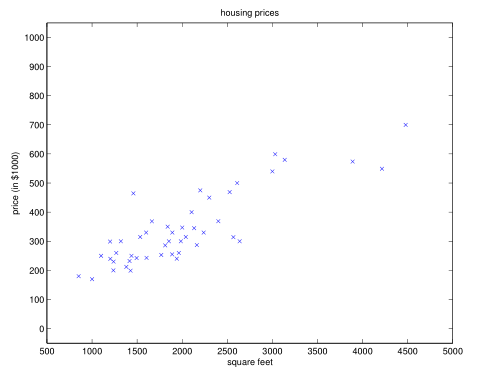本学习笔记参考自Andrew的机器学习课程(点此打开), 内容来自视频以及其讲义, 部分内容引用网友的学习笔记,会特别注明
课程前言
1.机器学习可以看到是很跨领域的,神经学,自然语言处理,等等,机器学习的实用性非常广
2.课程中的作业需要用到MATLAB软件编写实现一些学习算法,但是正版需要收费,OCTAVE是免费的,提供了一些跟MATLAB差不多的功能,但总的来说功能要少一些,不过对这门课程来说够用了 。
课程内容
一.机器学习定义(Machine Learning Definition)
Arthur Samuel: Field of study that gives computers the ability to learn without being explicitly programmed
这里Andrew举例Arthur Samuel的一个西洋棋程序例子,他的西洋棋程序可以自行学习如何下棋来战胜对方,但他并不是明显的写程序规则等来说明西洋棋应该如何去下棋,这个例子是上面定义的一个理解。
Tom Mitchell: A computer program is said to learn from experience E with respect to some task T and some performance measure P, if its performance on T, as measured by P, improves with experience E.
二.监督学习(supervised learning)
监督学习就是给算法提供了一套标准答案,让算法自行学习标准输入与标准输出答案之间的关联,以便来预测其他输入的输出。
这里举例的是预测一个给定面积的房价,下面是图收集到的面积与房价的关系图,可以看做是现有的标注输入与答案。这其实也是一类回归问题,回归问题可以简单理解为如何去寻找多个自变量与因变量之间关系,即找出因变量与自变量之间的函数关系式

另一类监督学习问题是分类问题,分类问题处理的变量是离散的。这里举例为乳腺癌的性质(良性或恶性)与肿瘤大小的关系,其中肿瘤要么为良性要么为恶性,所以这里因变量是离散的,上面的回归问题的因变量是连续的,这是区别。这里也是通过给定肿瘤大小来预测是良性还是恶性,也就是分类。当然现实情况会复杂很多,不只是肿瘤的良性还是恶性会与多个因素相关,比如年龄,肿瘤大小等,这个时候的输入特征是二维的。如果输入特征向量是更多维的,那么就不能画图来表示出来了,有一种称为支持向量机(SVM)的算法是用来解决它的。
三.学习理论(learning theory)
这部分讲机器学习的理论以及算法介绍,比如你如何知道你的训练样本是否以及足够,,从Andrew的讲解来看,更重要的是机器学习的理念,原话是这样的:the skills to really take the learning algorithm ideas and really to get them to work on a problem
四.无监督学习(unsupervised learning)
无监督学习与监督学习的区别就是给你提供数据,但不给你提供正确答案。这里了很多例子,都是聚类,即给一组数据,然后将数据分成多个类别
五.强化学习(reinforcement learning)
强化学习的最基本的概念是回报函数的概念,需要找到一种方式去定义好的行为和坏的行为,用回报函数去奖励好的行为,惩罚坏的行为,用这种方式去学习
六.总结
上面的几个模块就是该课程内容后续将要仔细学习的内容






















 880
880

 被折叠的 条评论
为什么被折叠?
被折叠的 条评论
为什么被折叠?








